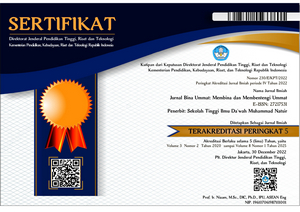KONSEP TAUHID PERSPEKTIF NASHIR AL-UMAR: IMPLEMENTASI DALAM DAKWAH DAN PENDIDIKAN DI ERA MODERN
DOI:
https://doi.org/10.38214/jurnalbinaummatstidnatsir.v8i1.338Keywords:
Tawhid, Contemporary Da'wah, Islamic EducationAbstract
Penelitian ini membahas konsep tauhid dalam perspektif Nashir al-Umar serta implementasinya dalam dakwah dan pendidikan di era kontemporer. Metode yang digunakan dalam penelitian ini adalah studi kualitatif kepustakaan dengan pendekatan deskriptif-analitis terhadap karya-karya Nashir al-Umar. Hasil penelitian menunjukkan bahwa dakwah dan pendidikan berbasis tauhid perlu diarusutamakan melalui media-media dakwah digital, penguatan kurikulum di lembaga pendidikan Islam, serta peran sentral keluarga sebagai wadah awal pembinaan tauhid. Selain itu, penggunaan teknologi informasi harus dimaksimalkan untuk menyampaikan pesan-pesan tauhid secara moderat dan efektif. Penelitian ini memberikan kontribusi teoritis dalam memperkaya wacana keislaman dan dakwah, serta implikasi praktis bagi para dai, pendidik, dan pengambil kebijakan dalam membentuk generasi muslim yang kokoh dalam aqidah dan tangguh menghadapi tantangan zaman.
Published
Versions
- 2025-06-11 (2)
- 2025-06-04 (1)
Issue
Section
This work is licensed under a Lisensi Creative Commons Atribusi 4.0 Internasional.
Authors who publish with this journal agree to the following terms:
- Authors retain copyright and grant the journal right of first publication with the work simultaneously licensed under a�Creative Commons Attribution License that allows others to share the work with an acknowledgment of the work's authorship and initial publication in this journal.
- Authors are able to enter into separate, additional contractual arrangements for the non-exclusive distribution of the journal's published version of the work (e.g., post it to an institutional repository or publish it in a book), with an acknowledgment of its initial publication in this journal.
- Authors are permitted and encouraged to post their work online (e.g., in institutional repositories or on their website) prior to and during the submission process, as it can lead to productive exchanges, as well as earlier and greater citation of published work (See�The Effect of Open Access).



